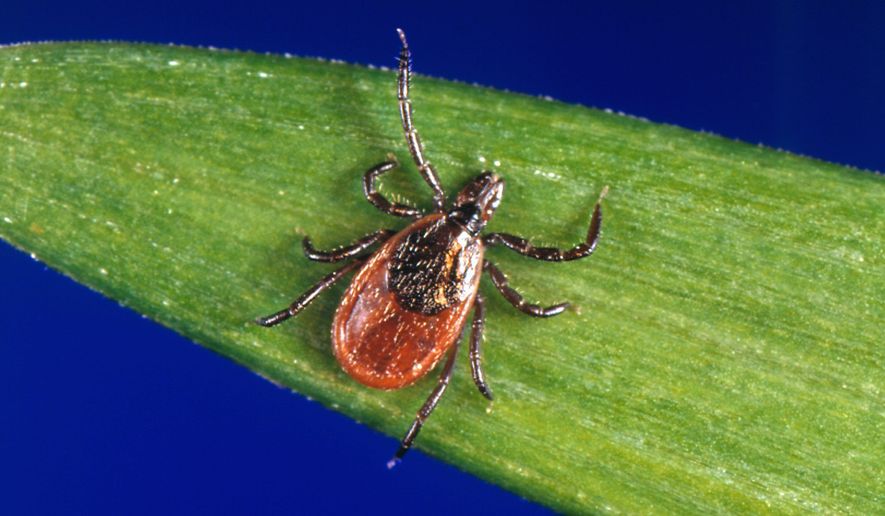Remember West Nile virus? Lyme disease? Eastern Equine Encephalitis? These menaces to health may have fallen from headlines in the age of the coronavirus pandemic, but are still prevalent among the general population, officials say.
With so much attention being paid to COVID-19, public health officials are urging people not to forget about mosquito- and tick-borne diseases as warm weather approaches.
“As the summer picks up, vector-borne diseases will become more evident,” said Dr. Georges Benjamin, executive director of the American Public Health Association. “We need to be on high alert for these and take inventory of our mosquito control program and other environmental programs.”
He said climate change is exacerbating mosquito-borne illnesses by worsening heavy rainfall that can lead to floods, contamination of drinking water and an increase in infectious vectors.
Of the more than 200 types of mosquitoes in the U.S., about 12 types spread germs that can make people sick, according to the Centers for Disease Control and Prevention. The U.S. has experienced dengue, chikungunya and Zika virus outbreaks in places like Florida, Hawaii, Texas, Puerto Rico, the U.S. Virgin Islands and American Samoa.
Eight cases of dengue in the states and 228 cases in U.S. territories have been reported this year as of May 5, the CDC says. Twenty-six cases of chikungunya virus disease have been reported in 2020, most of them from travelers returning from an affected area, the CDC reported in April. There is no transmission of the Zika virus currently in the continental U.S. , including in Florida and Texas where cases were reported in 2016 and 2017.
West Nile virus is the most common mosquito-borne disease in the U.S. There are no vaccines or treatment for the illness, but most infected people do not feel sick. Forty-four states reported West Nile infections to the CDC in 2020, as of Jan. 5. The CDC said 557 cases of the disease have been reported.
The U.S. also gets a few cases of Eastern Equine Encephalitis, a rare cause of brain infections, each year. Most cases occur in eastern or Gulf Coast states.
David Brown, technical adviser for the American Mosquito Control Association, told The Washington Times that more examples of invasive mosquitoes and the pathogens they carry are arriving in the U.S. and expanding their ranges within the country, adding that more options to effectively control mosquitoes are needed.
Mosquitoes are starting to develop resistance to current control methods such as insecticides, the Florida Keys Mosquito Control District said.
As an experiment, British-based biotech firm Oxitec genetically engineered Aedes aegypti non-biting male mosquitoes to carry a lethal gene that gets passed onto their offspring when they mate with wild biting female mosquitoes. The offspring are unable to survive, hence controlling the population of disease-carrying species, said the FKMCD, one of the entities that approved the firm’s project.
Release boxes containing the genetically engineered male mosquitoes were placed in six locations in late April — two on Cudjoe Key, one on Ramrod Key and three on Vaca Key — with thousands starting to emerge this month. Around 12,000 mosquitoes are expected to emerge each week for about 12 weeks.
Ticks are another thing to be on alert for during warmer months.
The most common tick-borne illness in the U.S. is Lyme disease. About 30,000 cases of Lyme disease are reported to the CDC each year. However, experts say cases are largely underreported and estimate that about 476,000 people in the U.S. may get Lyme disease each year.
Other common tick-borne diseases in the U.S. include babesiosis, ehrlichiosis, Rocky Mountain Spotted Fever, anaplasmosis, Southern Tick-Associated Rash Illness, Tick-Borne Relapsing Fever and tularemia.
In its 2021 forecast, Pests.org said that tick populations are likely to be bigger than usual and that warmer weather months expose people to ticks for much longer than average. Although the Southeast might not see more tick activity, the pest control website says most states will have warmer, wetter conditions that drive tick populations and the possibility of tick-borne diseases “skyward.”
Experts also are warning about ticks near beaches and not just in woodland areas.
Daniel Salkeld, a Colorado State University environmental and occupational health instructor who has studied infected ticks near Northern California beaches, said coastal ticks can also be infected with Lyme disease bacteria. The proportion of infected ticks near beaches was similar to woodland areas, he said.
The host of these infected ticks is a “mystery,” the scientist added.
“In California woodlands, western grey squirrels are often the reservoir that is infected with Lyme disease bacteria. In areas of coastal scrub I’m not sure what the reservoir would be — maybe wood rats? Voles? Rabbits? We have to carry out surveillance in these areas to find out,” he said. “That ecology of diseases is local — we’ve tended to focus on woodlands in California and maybe neglected coastal areas. But there is still a risk of tick-borne disease in those areas. And that leaves us wondering what animal is the source of infections in coastal areas.”
• Shen Wu Tan can be reached at stan@washingtontimes.com.




Please read our comment policy before commenting.